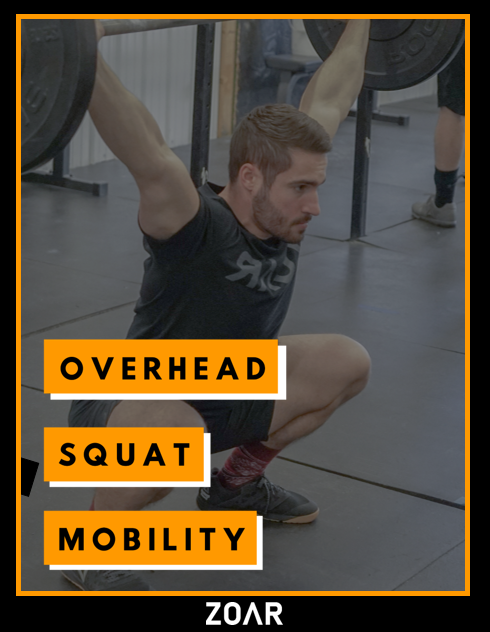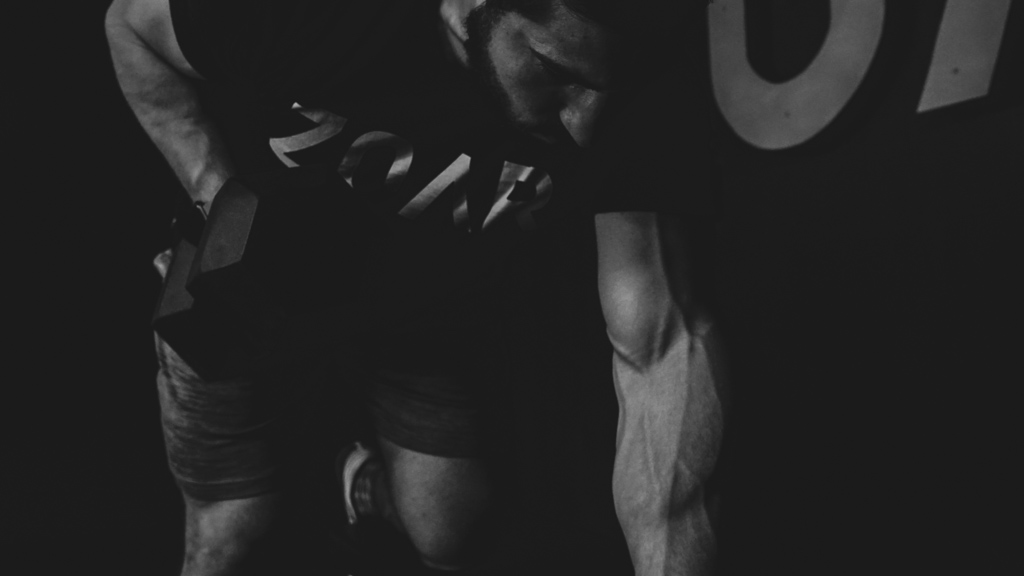Pistols -single legged squats- are one of the few lower body dominant gymnastics (bodyweight) movements that are frequently tested in the Sport of Fitness. The majority of gymnastics movements are either inverted (Handstand Push-Ups, Handstand Walks) or on a pull-up bar (Chest-to-Bar, Toes-to-Bar, Bar Muscle-Up, Ring Muscle-Up), both which are upper body centric.
Burpees and air squats are both bodyweight movements that could be considered to fall into the gymnastics category, but they usually pose as metabolic (engine) limitations rather than skill, strength or mobility limitations.
As we know, pistols require a blend of all three of these components, making them uniquely difficult for many athletes.
Mobility – Strength – Skill
To maximize your potential, capacity and efficiency for Pistols you must master the movements specific mobility, strength and skill demands: the three-headed monster every athlete must conquer. Let’s take on the monster one “head” at a time.
Mobility Requirements
There are three main types of mobility that are necessary for pistols…
(1) Ankle Dorsiflexion
Lots of athletes have a terrible time keeping their heels grounded while doing pistols. Even many regional level athletes (Watch 2018 Regionals Event 3) have a tough time. This is rarely an issue solely with the ankle joint, but likely they do have some limitations there as well. Here is a quick test to see if you do, in fact, have an ankle mobility limitation…
Why does the pistol demand so much more of your ankle mobility than an air squat?”
Well, in an air squat, you can spread your feet to shoulder width and use your hip mobility much more, which allows less of the ground to be made up at your ankles.
Noah Ohlsen is an athlete who takes full advantage of his hip mobility while bilateral squatting. You can see in this video that his knees never track that far forward in the bottom of his squat. Compare that to the video of this Weightlifter snatching, who clearly uses a substantial amount of forward knee travel and ankle mobility.
So, in short, you can’t escape poor ankle mobility in the pistol by disguising it with your stance width and hip range of motion.
This is a concept I explain more here…
If you know ankle mobility is a limitation for you, here the three top stretches I would recommend…
• Squatting Ankle Mobilization
While you’re working on your ankle mobility, you can still practice Pistols by using a plate to limit the dorsiflexion needed…
(2) Hip Flexion & Core Compression
While the ankle does contribute significantly to the challenge of the pistol, the hip has equal demands, just in ways that aren’t commonly required for other squatting movements.
The hip flexors and quads must be strong at near end range (more on that later on), but the mobility requirement is actually on the other side of those joints: the muscle groups put on stretch. Deep hip flexion while folding the body requires flexibility in the posterior chain so that the muscles on the anterior (front of the body) don’t have to work so hard to overcome this tension.
You’ll need plenty of range in hinging musculature (mainly hamstrings and low back).
(3) Hip Adduction & Internal Rotation
Another thing to consider is how much closer the femurs are to the midline of your body throughout the pistol versus a squat. This is a fundamental difference between a bilateral (2-sided) movement like a squat, and a unilateral (1-sided) movement.
In the Pistol you are standing on one leg, so to maintain balance you must have that one point of contact directly under your center of mass.
This isn’t a big deal when you’re standing, but as you descend in the squat your femur must come towards the midline of your body (adduction). And to maintain a vertical shin (avoiding valgus knee) you must internally rotate the femur at the hip.
You can see this motion clearly from Colleen Fotsch’s pistols in the fourth video in this post.
This is a unique combination of ranges that -frankly- most athletes don’t have.
• Glute Med Stretch: my favorite for developing hip adduction
• Banded Hip Internal Rotation Stretch: my favorite for developing femoral internal rotation
Strength Requirements
(1) Unilateral Squat Strength
At first glance, it seems like pistols should be exactly twice as difficult as a bodyweight squat: one leg versus two right? Not exactly.
The level of strength required to move effectively while balancing on one leg is much more complicated than the primary drivers of the movement. You have to fight to keep your hips level, to keep your knee tracking in the right position, and to keep arch support with your feet.
However, there’s no way around it, if your legs don’t have the raw strength needed, you won’t be able to do pistols.
Accessory Exercises to Build Unilateral Squat Strength…
• Walking Lunge Variations
• Reverse Lunge Variations
• Weighted Box Step-Ups
• Box Step-Downs
• Cyclist Squats
• Bulgarian Split Squats
• Front Foot Elevated Split Squats
(2) Hip Flexion & Core Compression
One of the main ways the hips & quads are uniquely taxed in the pistol is with hip flexion demands. The athlete must prevent their elevated leg from touching the floor to meet the movement standard.
Why do my quads get so sore from pistols?”
In the pistol, your quads get “double dipped.” They get harnessed once when the grounded leg extends the knee, and then they get harnessed again when they aid in hip flexion (and knee extension) to keep the hovering leg from touching the floor.
Accessory Exercises to Build Hip Flexor Strength & Core Compression Ability…
• L-Sits & L-Sit Raises
• Tuck Holds & Hanging Knee Raises
• Strict Toes-to-Bar & Hanging Leg Raises
• Plank Variations & Inchworm Planks
• Slider Plank Pikes
If you are a person who lacks hip flexor strength, here’s a great variation that allows you to practice pistols…
(3) Glute Stability & Strength
The outside of the hip (mainly the Gluteus Medius) is responsible for hip abduction and keeping the hips level during the pistol. Otherwise the pelvis will sag to one direction, with the ball of one hip sitting higher than the other.
The glute med and other musculature on the outside of the hip is also tasked with providing stability and proper tracking for the knee. If you’re knees are caving or shaky during pistols, look to your hip stability first, then to the arches of your feet.
Accessory Exercises to Build Hip Stability and Strength…
• 2-Way Banded Side Step
• Seated Banded Hip Abductions
• Monster Walks
• Single Leg Balance Drills
• RNT Reverse Lunges
• Clam Shells
• Star Side Planks
(4) Arch Foot Stability & Strength
Pairing closely with hip stability, arch stability is another important component of balancing in the Pistol. Often athletes lose their arch because of two reasons: hip instability / lack of torque and ankle dorsiflexion limitations. Likely if you are unable to maintain an arch in your foot, it’s an issue with one (or both) of those two.
Accessory Exercises to Build Arch Stability & Strength…
• Banded Arch Support Drills (Version 1)
• Banded Arch Support Drills (Version 2)
• Single Leg Balance Drills
• Stop wearing shoes all the time (especially lifters).
• Working on your ankle mobility (see above)
Skill Requirements
(1) Warm-Up Well
Pistol Prep Routine
A. Deck Squat (2 x 5) Rest 30s
B. RNT Reverse Lunge Hold; Laterally Banded (2 x 10s Static / side)
*trailing knee 1″ off ground
C. Feet-together Squat Holding Plate (3 x 5) w/ 5sec pause at bottom for each; rest as needed
Here’s another simple warm-up routine…
(2) Practice the Actual Skill
Usually I see athlete’s make one of two mistakes…both which prevent them from practicing pistols.
Bill: He attempts Pistols again and again, only to fall on his bum rep after rep. There’s no mindful approach to the practice or attempt at mastering the mobility and strength needed. It’s simply a “I just need to try harder” approach. Don’t be Bill.
Barbara: She takes a much more mindful and tactical approach, yet still neglects to practice the specific movement. She works on her split squat strength, practices deck squats, incorporates L-Sit raises, and works on her ankle mobility. It’s certainly a whole lot better than Bill’s approach, but it’s still not ideal. At the end of the day, she still hasn’t done anything that truly resembles the blend of strength, mobility and skill needed to do a Pistol.
But I can’t do Pistols.”
This is where scales come in. In addition to attempting actual pistols and building the individual qualities necessary to be successful, scales allow you do practice the skill very closely to what an actual pistol will feel like.
The first scale is my personal favorite: the Band Assisted Pistol.
(3) Toe-Hold or Nah?
The Toe-Hold is just like it sounds…in the middle of your pistols you bend forward and grab the forefoot of your shoe.
Why? It reduces the demand of your hip flexor and quads slightly because you are working as hard to hold your leg up.
However, I don’t recommend everyone does this. And most elite athletes don’t. For them, it’s a matter of it slowing down their cycle speed.
The Toe-Hold might work for you if… you are in a workout where cycle speed doesn’t matter as much and you are an athlete with good hamstring and low back flexibility.
(4) Spine Flexion: Should I Round?
Sometimes athletes work really hard to maintain a neutral spine (read “flat back”) when performing Pistols. Other athletes have a significant amount of rounding as they move through Pistols. Which is right?
For most athletes, most of the time, a (somewhat significant) amount of back rounding (spinal flexion) will be necessary to complete Pistols.
The exception would be an athlete with short limbs, a long torso and great ankle mobility. However, this is far from the norm. Athletes with long limbs, shorter torsos and sub-par mobility will have no choice but to round with their back and reach as far forward with their hands as possible to counterbalance the movement.
This is a normal (and quite possibly) unavoidable part of the Pistol. After all, pistols are known to pump out athlete’s low backs.
The Wodapalooza Workout Shark Bait was a perfect example of a lower back destroyer featuring High Volume D-Ball over the Shoulders and Pistols.
The bottom line…don’t try to avoid rounding your back, but do be smart in how you move in the other movements the pistols are paired with when your low back is fatigued.
(5) Be Methodical
Option 1: The Piston Pistol (Straight Up & Down)
Here you -like a piston- move completely vertically. There is minimal side-to-side movement and minimal “wasted movement.” While this version allows for faster cycle speeds, it is often a challenging movement to maintain over the course of many reps if you aren’t advanced at Pistols.
Option 2: The Sway Step (Side-to-Side Action)
For most athletes, standing on both feet for a moment before balancing again as you enter the next rep helps give your hips a quick break and supports the longevity of the movement. Sure you can stand on two feet for a moment doing the Piston Pistol, but it’s not nearly as comfortable or as well balanced.
The question is…. Is sustainability or cycle speed more important for how your current capacity intersects with the workout at hand?
(6) Build Volume & Density
In other words, don’t build intensity by adding weight.
Historically speaking, it’s extremely rare that pistols will be tested with external load added. The 2013 Games Final was one of these rare examples.
The vast majority of the time, especially in Online Qualifiers (like the Open), you are going to see them done the traditional way – with one’s bodyweight.
Anytime a competition is using a bodyweight movement as a test, it’s necessary to make it challenging enough where there’s separation among a field of talented athletes. The only way to do this is by adding reps (volume) or increasing the chunking or frequency (density) that is required.
For example, 20.4 required 3 sets of 30 pistols after 90 box jumps and a whole bunch of clean and jerks. The combination of movement interference (all use the quads) and volume and chunking of work made these pistols extremely challenging for the average athlete who made it that far into the workout.
And in a workout like “Mary” (Start at 32:50 or 1:41:40), top athletes did over 200 pistols. That’s like doing a 20 minute EMOM of 10-12 pistols.
TLDR | Here’s the Summary
Mobility Requirements: Ankle Dorsiflexion, Hip Flexion + Adduction + Internal Rotation
Strength Requirements: Hip Flexors, Quads, Glute Med, Arches of Feet
Skill Requirements:
- Warm-Up Well: use a progression that suits your personal needs
- Practice the Actual Skill: Even if it means finding a scaled version
- Toe Hold or Nah?: Personal preference that is largely dictated by hip flexor strength + endurance vs. hinging flexibility
- Spine Flexion: unless you have short limbs, you’ll likely need to round your back
- Be Methodical: learn different variations and styles of how to alternate between your legs
- Build Volume & Density: If you want to be prepared for the Sport.

Overhead Squat Mobility
(6-Week Program)
The Overhead Squat is a notorious movement because of it’s extreme mobility demands.
Is your ability to get in a good position preventing you from expressing your true strength and fitness?
This is the place to start.


